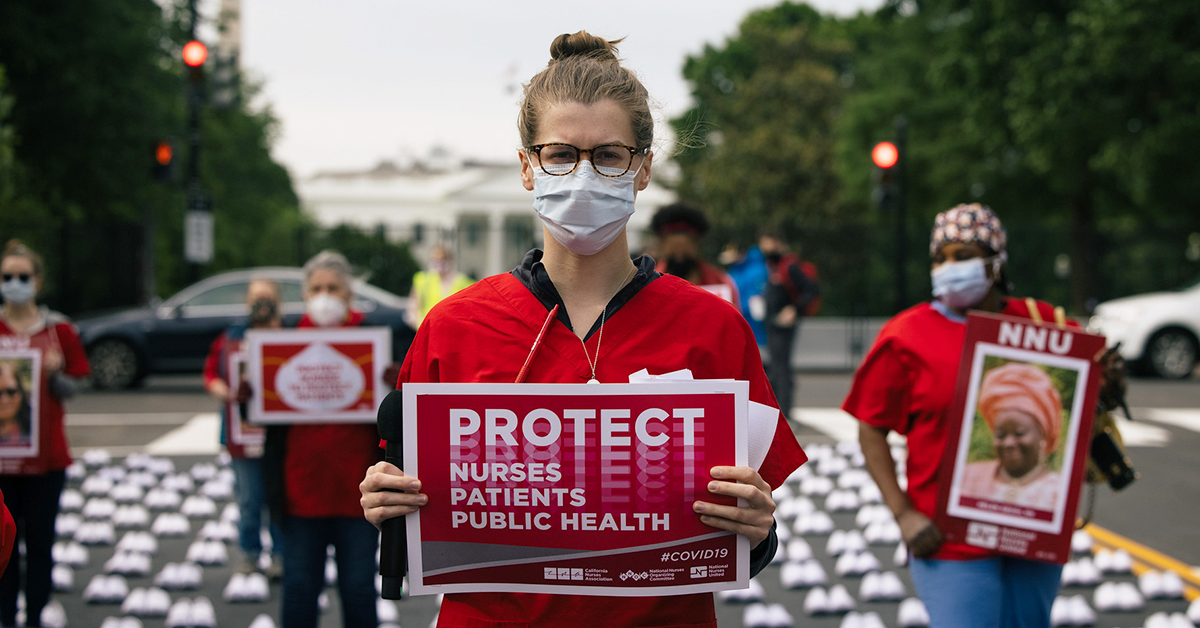OSHA Covid-19 Emergency Temporary Standard

Nurses have won a historic national standard! Learn what is now required
This first-in-the-nation enforceable federal Covid-19 standard only happened because nurses across the country advocated relentlessly for safe workplaces. Despite extensive opposition and lobbying by the hospital industry, nurses won the first OSHA emergency temporary standard since 1983. The Covid-19 ETS is an important step to improve the safety of workplaces for nurses, other essential health care workers, and our patients, which we know is necessary to ensure the safety of our families and communities. Onwards to enforcement!
OSHA’s Covid-19 ETS requires health care employers to do the following:
- Written Plans and Employee Involvement: Employers must establish facility-specific written Covid-19 plans created with the input of non-managerial employees and their union. Employers must also provide training to all employees regarding the employer’s Covid-19 plan and other required topics. The written plans must be made available to employees and their union upon request, by the end of the next business day.
- Covid-19 Hazard Assessment: Employers must conduct a Covid-19 hazard assessment and implement a plan to address Covid-19 hazards to minimize the risk of transmission at each facility and for each employee.
- Patient and Visitor Screening: Employers must screen all patients, visitors, staff, and others who enter the facility for Covid-19 and restrict entrances to the facility to prevent introduction of the virus. Employers must promptly isolate patients who may have or are confirmed to have Covid-19 in airborne infection isolation rooms or single-patient exam rooms with the door closed.
- Personal Protective Equipment: Employers must provide personal protective equipment (PPE) to all employees who may be exposed to Covid-19, including all of the following:
- Respiratory protection at least as protective as an N95 filtering facepiece respirator.
- Eye protection.
- Isolation gowns.
- Medical grade gloves.
- Voluntary Respirator Use: Employers cannot deny nurses and other health care workers their right to voluntarily use their own respirators instead of facemasks, where facemasks are required (e.g., hallways, breakrooms, and non-Covid areas).
- Other Infection Control Measures: Employers must implement a multiple measures approach to prevent Covid-19 transmission within the facility, including improving ventilation rates and air filtration levels, requiring everyone present in the facility to wear face masks and observe physical distancing, and conducting frequent environmental cleaning.
- Employee Exposure Notification: Employers must notify employees of an exposure to a person with Covid-19 in the workplace within 24 hours of the employer becoming aware of the exposure. Notification is required when employees who were not wearing a respirator and other required PPE had close contact with (within six feet for a cumulative total of 15 minutes over a 24-hour period) or worked in the same area with a Covid-positive individual during that individual’s infectious period (from two days before symptom-onset, or first positive test if asymptomatic, until the time the person is isolated).
- Medical Removal and Removal Protection Benefits: Employers must provide medical removal and medical removal protection benefits, with some exceptions, to staff who are Covid-positive or have been told by a health care provider that they are suspected to have Covid-19, who are experiencing a recent loss of taste and/or smell with no other explanation, who are experiencing a fever (≥100.4°F) and new unexplained cough associated with shortness of breath, or who have had recent close contact, without wearing a respirator and other required PPE, with a Covid-positive individual in the workplace. Employers must provide medical removal protection benefits to employees who are medically removed from the workplace under the ETS, including pay and benefits and ensuring no adverse action upon return to work.
- Paid Leave for Vaccination: Employers must provide reasonable time for employees to get vaccinated and to cover sick time for Covid-19 vaccine side effects.
- Anti-Retaliation Protections: Employers are prohibited from retaliating against an employee for exercising their rights under the ETS.
- Covid-19 Log: Employers must track all employee Covid-19 cases in a Covid-19 Log, regardless of work-relatedness. The Covid-19 Log, written Covid-19 plan, and other records of implementation required by the ETS must be made available to employees and their representatives by the end of the next business day.